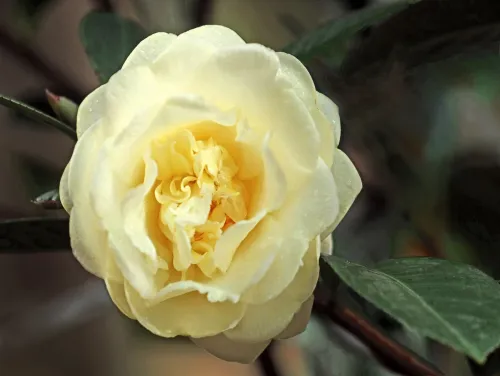An excellent cultivar derived from F2 hybrids of Camellia nitidissima
Huang Liandong*, Li Zhihui
Nanning Golden Camellia Park, Guangxi, China
* Author for correspondence
Introduction
Guangxi is the hometown of Golden Camellias, where 35 wild species were found with yellow flowers. The hybridization work on these yellow camellias has been done for many years. Although we have obtained many F1 hybrids, it was hard to find a good seedling with good ornamental characteristics. So we continued to do some backcross pollination, and finally achieved some F2 hybrids with excellent ornamental characteristics. In this paper, we would like to introduce this new cultivar as follows.
Breeding procedure
F1 plants were pollinated in 1984, using Camellia nitidissima as the female parent,andC. sasanqua ‘Dark red sweet’ as the male parent. In the 1990s, some F1 hybrid seedlings begin to bloom, and we used them as parents to breed new cultivars, but many experiments had no good results. Finally in 2004, we used one F1 seedling as a female parent, and backcrossed with C. nitidissima. Intotal we pollinated 98 flowers and 4 of them bore fruits so the rate of fruit set is around 4%. From the 4 fruits, we obtained five seeds that weighed 0.8 g, 0.4 g, 0.5 g, 1.4 g and 3.0g. Four of them failed to germinate; only the 2nd heaviest seed (1.4 g) germinated and became a plant. In 2009, this plant came into bloom, and showed excellent ornamental characteristics (as shown in Fig. 1). We then did some graft propagation and got several individuals that showed stable characteristics as those of the F2 hybrid plant. Then we named this new cultivar Camellia ‘Dongyue’ which was published in China Flowers & Horticulture (2010, No.16, p.44).
Description of this cultivar
Evergreen shrubs to small trees, 70cm tall now with a trunk of 2.24cm,medium growth rate. The bark of trunk is grey-brown, nearly smooth or slightly split. Young shoots are pale purple and glabrous. Terminal buds yellowish-green with slightly reddish color, oblate in shape, 2.6cm long and 1.2cm wide, about 7 piece bracts in imbricate arrangement, subglabrous, margin slightly green tomentose. Juvenileleaves reddish brown and glabrous; mature leaf shapes vary greatly in size in the same plant, ovate or elliptic, 6 - 10cm long, 3 - 6.5 cm wide; apices caudate to acute with the tips up to 0.5-1cm long; bases cuneate; margins hard serrate; blades bright and deep green at the upper surface, light green at the back, both sides glabrous, midrib obvious, lateral veins 7-9 pairs; petiole 0.7 - 1cm long with a longitudinal shallow groove, green and glabrous. Flowers single or more than 2 fascicled, axillary or terminal, flower about 6 - 7cm in diameter, pedicel about 0.2cm long, purple white; bracts and sepals 5 in green, with gray tomentose, broadly ovate, apex obtuse, length increased to 1.5 -2mm long with 1.5 - 1mm wide when in full bloom. Sepals 5-6 in complex imbricate arrangement, semiorbicular to broadly obovate, 2 - 6mm long and 2 -3mm wide, apex nearly orbicular or ovate, glabrous both sides. flower is rose form, milky yellow,6-7 cm in diameter, stamens mostly petaloid, pistils 3 cracked. Ovary glabrous. The flowering season is from January to March.
 |
 |
Fig. 1 the plant and the flower of the new cultivar Camellia ‘Dongyue’
Table 1 comparison of the new cultivar ‘Dongyue’ to its parents
|
Iterms
|
Leaf Size (cm) |
shoots |
pedicel (cm) |
Flower color |
flower size
|
fragrance |
|
Male parent : Camellia nitidissima |
11—16 long 4—6 wide |
glabrous |
0.51long |
Golden yellow and waxy |
6—8cm with 8—11 petals |
none |
|
Female parent Fa Seedling |
6—7 long 3—5 wide |
tomentose |
none |
pink |
6—7cm with 20—30 petals |
Light sweet |
|
F2 ‘Dongyue’ |
6-10 long 3-6.5 wide |
glabrous |
none |
yellow |
6—7cm with 26—30 petals |
none |
We have done more hybridization using the F1 hybrid as parents. We successfully get the pale yellow flowers from the hybrid of Camellia euphlebia×returnF1. The flowers of F2 plants are no longer single and red but show yellow. Other experiments show the same results when more backcrosses with Camellia nitidissima are done. These F2 hybrids dominate in yellow when that F1 plant is crossed with the wild yellow species. Crossing several times, again and again, is an important way to breed new yellow cultivars.
Reference
Xia L.F. Wang Z. L. And Feng B.J. 2007. Talking about the breeding of camellia. The proceedings of 1st annual symposium on Camellia Breeding. 2-3
Chen J.S, Chen J.Y and Zhao S. W. 1994. A study of hybridization of Camellia chrysantha. Journal of Beijing Forestry University 16(4):55-59
Feng Z.H, Huang L.D. 1987. A primary report on breeding of Camellia chrysantha. Journal of Beijing Forestry University 9(4):374-379
Web design by Tribal Systems
